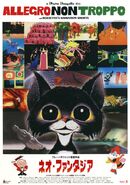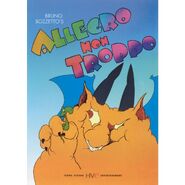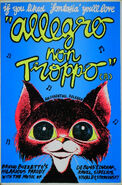Allegro Non Troppo is a 1976 Italian animated film directed by Bruno Bozzetto. Featuring six pieces of classical music, the film is a parody of Walt Disney's Fantasia, two of its episodes being derived from the earlier film.[3] The classical pieces are set to color animation, ranging from comedy to deep tragedy.[4]
Program[]
- Claude Debussy's Prélude à l'après-midi d'un faune, an elderly satyr repeatedly attempts to cosmetically recapture his youth and virility, all in vain.[3] With each failure, the satyr gets smaller and smaller, until he roams across a vast countryside which turns out to be a woman's body.
- Antonín Dvořák's Slavonic Dance No. 7, Op. 46, begins in a large community of cave-dwellers. A solitary cave man wants to better himself and builds himself a new home. From this point on, the rest of the community copies everything that he does.[3] He is annoyed that everyone is able to keep up with his advances so quickly. His attempts to break away from them leads to his planning a bizarre act of mass vengeance with unintended and humorous consequences.
- Maurice Ravel's Boléro, primordial sugar water at the bottom of a Coca-Cola bottle left behind by space travelers attains life, and progresses through fanciful representations of the stages of evolution and history until skyscrapers destroy all that has come before. This segment parallels The Rite of Spring segment from Fantasia, complete with a solar eclipse. Its opening moment was used as the image for the film poster.
- Jean Sibelius' Valse triste, a cat wanders in the ruins of a large house. The cat remembers the life that used to fill the house when it was occupied.[3] Eventually all of these images fade away, as does the cat, just before the ruins are demolished.
- Antonio Vivaldi's Concerto in C major, RV 559, a female bee prepares to dine on a flower in elaborate style replete with utensils and a portable TV, but is continually interrupted by two lovers sitting down for a romantic interlude on the grass.[3] After having her meal interrupted several times, each time being forced to gather up her things and scramble to safety. In the end she stings the male.
- Igor Stravinsky's The Firebird (specifically The Princesses' Khorovod and The Infernal Dance of King Katschey) begins with a lump of clay molded by a monotheistic symbol of the omniscient pyramid, first making a few unsuccessful creatures with overly awkward limbs, then finally the Adam and Eve as portrayed in Book of Genesis. Adam and Eve then transform into cel animation and, as in Genesis, the serpent comes up to them, offering the fruits of knowledge in the form of an Tree of the knowledge of good and evil with an apple. After they refuse it the serpent swallows the apple himself. Falling asleep, he is immediately plunged into a nightmare in a hellish environment where he is first tormented by fiery demons and then plagued by things that are supposed to corrupt humankind (sex, alcohol, money, material objects, drugs, violence);[3] he also grows arms and legs and is magicked into a suit and fedora. When the music ends after he wakes up, he sheds the suit (losing his arms and legs but keeping the hat) and spits up the still-whole apple.
Live action sequences[]
The uncut film also contains comic live action sequences, in black and white blended with occasional color animations, that parody the Deems Taylor introductions from Fantasia. "The Presenter" (Maurizio Micheli) starts off with an exaggerated version of Taylor's opening introduction in Fantasia ( "A new and original film" .. "you will see the music and hear the drawings" .. "a fantasia") only to be interrupted by a phone call from California informing him that the movie had already been done. He angrily objects, dismissing the caller as an ill-mannered liar, explaining to the audience that the caller claims that someone ("Prisney", "Grisney", "some American") had done this years before, then telling the caller to at least watch the movie and hangs up. Next the Presenter introduces "The Orchestra Master" (Néstor Garay) and an orchestra made up of little old ladies as the Orchestra Master roughly rounds them up into a large trailer for transport to the theater. As the trailer heads out to the theater the Presenter exults "Pisney has already done this?". Lastly before the first animated music segment (Prélude à l'après-midi d'un faune), the Presenter introduces "The Animator" (Maurizio Nichetti).[3] as the Orchestra Master retrieves him from a dungeon-like cell in which the Animator ("a free artist") is chained to a wall (as the Presenter puts it: "a binding contract based on trust and mutual respect"). A pretty young cleaning woman (Marialuisa Giovannini) also appears in each segment, although she's barely acknowledged by any of the characters except the Animator (who seems to take an increasing fancy to her as the movie progresses). Each sequence portrays action (like the tossing of a Coca Cola bottle) that leads directly into the next animated portion of the film and occasionally includes references to a previous segment (such as a chamberpot appearing on the Orchestra Master's head or the female bee and the serpent from their respective segments appearing briefly in the subsequent live-action sequences). After the "Ravel's Bolero" chapter, a gorilla (inspired by the animated character in the Bolero) also appears a few times, first chasing then dancing with The Animator, then later beating up the Orchestra Master who has attacked the Animator. After the Firebird sequence, the Animator transforms the cleaning woman into a cartoon fairy tale princess and himself into a prince before both float away leaving the Presenter and Orchestra Master without a finale leading into the epilogue sequence.
- Directed, Produced & Written by Bruno Bozzetto
Credits[]
Prélude à l'après-midi d'un faune[]
- Directed & Written by Bruno Bozzetto
Slavonic Dance No. 7, Op. 46[]
- Directed, Produced & Written by Bruno Bozzetto
Boléro[]
- Directed by Bruno Bozzetto
Valse triste[]
- Directed, Written & Produced by Bruno Bozzetto
Concerto in C major, RV 559[]
- Directed, Written & Produced by Bruno Bozzetto
The Firebird[]
- Directed by Bruno Bozzetto
Gallery[]
External links[]
- ↑ Allegro non troppo. Public Media Home Vision (8 June 1994).
- ↑ Allegro non troppo.
- ↑ 3.0 3.1 3.2 3.3 3.4 3.5 3.6 Chris Hicks. "Allegro Non Troppo", Deseret News, 1991-03-12. Retrieved on 2011-12-05.
- ↑ Bruno Bozzetto to Receive ASIFA Prize.










